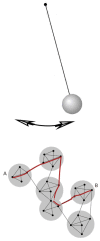How the Brain Becomes the Mind: Can Thermodynamics Explain the Emergence and Nature of Emotions?
- PMID: 37420518
- PMCID: PMC9601684
- DOI: 10.3390/e24101498
How the Brain Becomes the Mind: Can Thermodynamics Explain the Emergence and Nature of Emotions?
Abstract
The neural systems' electric activities are fundamental for the phenomenology of consciousness. Sensory perception triggers an information/energy exchange with the environment, but the brain's recurrent activations maintain a resting state with constant parameters. Therefore, perception forms a closed thermodynamic cycle. In physics, the Carnot engine is an ideal thermodynamic cycle that converts heat from a hot reservoir into work, or inversely, requires work to transfer heat from a low- to a high-temperature reservoir (the reversed Carnot cycle). We analyze the high entropy brain by the endothermic reversed Carnot cycle. Its irreversible activations provide temporal directionality for future orientation. A flexible transfer between neural states inspires openness and creativity. In contrast, the low entropy resting state parallels reversible activations, which impose past focus via repetitive thinking, remorse, and regret. The exothermic Carnot cycle degrades mental energy. Therefore, the brain's energy/information balance formulates motivation, sensed as position or negative emotions. Our work provides an analytical perspective of positive and negative emotions and spontaneous behavior from the free energy principle. Furthermore, electrical activities, thoughts, and beliefs lend themselves to a temporal organization, an orthogonal condition to physical systems. Here, we suggest that an experimental validation of the thermodynamic origin of emotions might inspire better treatment options for mental diseases.
Keywords: Carnot cycle; brain state; consciousness; emotions; resting entropy.
Conflict of interest statement
The authors declare no conflict of interest.
Figures




Similar articles
-
The thermodynamic brain and the evolution of intellect: the role of mental energy.Cogn Neurodyn. 2020 Dec;14(6):743-756. doi: 10.1007/s11571-020-09637-y. Epub 2020 Sep 25. Cogn Neurodyn. 2020. PMID: 33101528 Free PMC article. Review.
-
The thermodynamics of cognition: A mathematical treatment.Comput Struct Biotechnol J. 2021 Jan 12;19:784-793. doi: 10.1016/j.csbj.2021.01.008. eCollection 2021. Comput Struct Biotechnol J. 2021. PMID: 33552449 Free PMC article.
-
Action and Entropy in Heat Engines: An Action Revision of the Carnot Cycle.Entropy (Basel). 2021 Jul 5;23(7):860. doi: 10.3390/e23070860. Entropy (Basel). 2021. PMID: 34356401 Free PMC article.
-
Entropy, Carnot Cycle, and Information Theory.Entropy (Basel). 2018 Dec 20;21(1):3. doi: 10.3390/e21010003. Entropy (Basel). 2018. PMID: 33266719 Free PMC article.
-
Life, hierarchy, and the thermodynamic machinery of planet Earth.Phys Life Rev. 2010 Dec;7(4):424-60. doi: 10.1016/j.plrev.2010.10.002. Epub 2010 Oct 12. Phys Life Rev. 2010. PMID: 20970394 Review.
References
-
- Goldenberg A., Garcia D., Suri G., Halperin E., Gross J. Current Directions in Psychological Science. SAGE Publications; Thousand Oaks, CA, USA: 2017. The Psychology of Collective Emotions. - DOI
LinkOut - more resources
Full Text Sources
Miscellaneous

